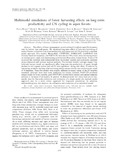Mostrar el registro sencillo del ítem
Multimodel simulations of forest harvesting effects on long-term productivity and CN cycling in aspen forests
| dc.creator | Wang, Fugui | es_ES |
| dc.creator | Mladenoff, David J. | es_ES |
| dc.creator | Forrester, Jodi A. | es_ES |
| dc.creator | Blanco Vaca, Juan Antonio | es_ES |
| dc.creator | Scheller, Robert M. | es_ES |
| dc.date.accessioned | 2020-09-07T08:46:36Z | |
| dc.date.available | 2020-09-07T08:46:36Z | |
| dc.date.issued | 2014 | |
| dc.identifier.issn | 1939-5582 | |
| dc.identifier.uri | https://hdl.handle.net/2454/38047 | |
| dc.description.abstract | The effects of forest management on soil carbon (C) and nitrogen (N) dynamics vary by harvest type and species. We simulated long‐term effects of bole‐only harvesting of aspen (Populus tremuloides) on stand productivity and interaction of CN cycles with a multiple model approach. Five models, Biome‐BGC, CENTURY, FORECAST, LANDIS‐II with Century‐based soil dynamics, and PnET‐CN, were run for 350 yr with seven harvesting events on nutrient‐poor, sandy soils representing northwestern Wisconsin, United States. Twenty CN state and flux variables were summarized from the models' outputs and statistically analyzed using ordination and variance analysis methods. The multiple models' averages suggest that bole‐only harvest would not significantly affect long‐term site productivity of aspen, though declines in soil organic matter and soil N were significant. Along with direct N removal by harvesting, extensive leaching after harvesting before canopy closure was another major cause of N depletion. These five models were notably different in output values of the 20 variables examined, although there were some similarities for certain variables. PnET‐CN produced unique results for every variable, and CENTURY showed fewer outliers and similar temporal patterns to the mean of all models. In general, we demonstrated that when there are no site‐specific data for fine‐scale calibration and evaluation of a single model, the multiple model approach may be a more robust approach for long‐term simulations. In addition, multimodeling may also improve the calibration and evaluation of an individual model. | en |
| dc.format.extent | 16 p. | |
| dc.format.mimetype | application/pdf | en |
| dc.language.iso | eng | en |
| dc.publisher | Ecological Society of America | en |
| dc.relation.ispartof | Ecological Applications, 2014, 24(6), 1374-1389 | en |
| dc.rights | © 2014 by the Ecological Society of America | en |
| dc.subject | Aspen forest ecosystem | en |
| dc.subject | Bio geochemical cycles | en |
| dc.subject | Bole-only harvest | en |
| dc.subject | Multiple model simulation | en |
| dc.subject | Nitrogen depletion | en |
| dc.subject | Soil carbon and nitrogen dynamics | en |
| dc.subject | Wisconsin, USA | en |
| dc.title | Multimodel simulations of forest harvesting effects on long-term productivity and CN cycling in aspen forests | en |
| dc.type | info:eu-repo/semantics/article | en |
| dc.type | Artículo / Artikulua | es |
| dc.contributor.department | Ciencias del Medio Natural | es_ES |
| dc.contributor.department | Natura Ingurunearen Zientziak | eu |
| dc.rights.accessRights | info:eu-repo/semantics/openAccess | en |
| dc.rights.accessRights | Acceso abierto / Sarbide irekia | es |
| dc.identifier.doi | 10.1890/12-0888.1 | |
| dc.relation.publisherversion | https://doi.org/10.1890/12-0888.1 | |
| dc.type.version | info:eu-repo/semantics/publishedVersion | en |
| dc.type.version | Versión publicada / Argitaratu den bertsioa | es |


